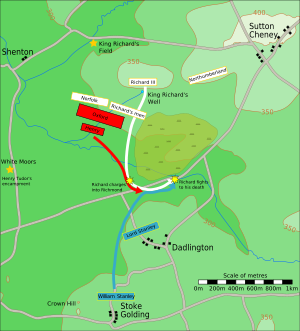Battle of Bosworth Field
Battle of Bosworth
Part of: Wars of the Roses

Battle of Bosworth (late phase)
Battles of the Wars of the Roses (1455-1485)
St Albans - Blore Heath - Ludlow - Northampton - Wakefield - Mortimer's Cross - St Albans - Ferrybridge - Towton - Hedgeley Moor - Hexham - Edgecote Moor - Losecote Field - Barnet - Tewkesbury - Bosworth Field - Stoke
The Battle of Bosworth or Battle of Bosworth Field is one of the main battles of the English Wars of the Roses, in which the forces of King Richard III were defeated by Henry Tudor, Earl of Richmond, who subsequently ascended the English throne as Henry VII. The armies of Richard III and Richmond clashed at Bosworth Field on August 22, 1485. The battle ended with the death of Richard III, who was the last English king to fall in battle. The battle was helped to be decided by Henry Percy, 4th Earl of Northumberland, keeping his troops neutral and Richard's allies Lord Thomas Stanley and Sir William Stanley changing sides. The Battle of Bosworth Field almost marked the end of the Wars of the Roses; the last resistance of Henry VII's opponents was ended with the Battle of Stoke.
Background
Henry Tudor, Earl of Richmond, was the last remaining claimant of the House of Lancaster to the English throne in 1485. He managed to gather sufficient support from the French and Scottish royal families while in exile in France. By promising to marry Elizabeth of York, daughter of Edward IV, he also gained support in the Yorkist camp. When Richard III, King of England and representative of the House of York, learned that Henry Tudor was planning an invasion of England, he gathered troops. In centrally located Nottingham, Richard hoped to strike quickly on all sides, depending on where Henry Tudor landed.
Henry Tudor finally left France on 1 August 1485 with an army of 600 exiles and 2000 French and Scottish mercenaries. On 7 August he landed at Milford Haven in Wales, hoping to gather further support in Wales through his uncle Jasper Tudor. He also attempted to contact his stepfather, Thomas Stanley, Lord Stanley.
Due to kinship relations with Richmond, Richard III distrusted Lord Stanley, so he held the latter's son, Lord Strange, hostage. Lord Stanley and his brother, Sir William Stanley, kept a low profile because of this situation and did not openly profess support for Richmond.
Richard moved his troops under the leadership of John Howard, 1st Duke of Norfolk, including an army under Henry Percy, 4th Earl of Northumberland, towards the village of Sutton Cheney. Richmond camped with his troops four miles away at Whitemoors, while the Stanleys positioned themselves some distance from both armies.
Consequences of the battle
The Battle of Bosworth spelled the end of the House of York. Many Yorkist members fell in the battle, including the Duke of Norfolk. The Earl of Northumberland, who remained largely neutral through inactivity in the battle, was initially captured but later released. He was allowed to return to his lands, but remained very unpopular in the north of England because of his attitude in the battle. Thomas Stanley was rewarded for his change of sides by Henry VII with the title Earl of Derby.
Henry, who can be considered a representative of the "red rose" of the former House of Lancaster, married the daughter of the late King Edward IV and thus an heiress from the House of York. The bitter feud between the two noble houses was largely ended by this, partly because a large proportion of the House of York had fallen in battle. Henry had to stand his ground against pretenders also afterwards, so in 1487 against Lambert Simnel, who however lost the Battle of Stoke, whereby the Wars of the Roses were finally ended.
Dynastically, the reign of the House of Tudor, which lasted 120 years until the death of Elizabeth I, followed.
Search within the encyclopedia